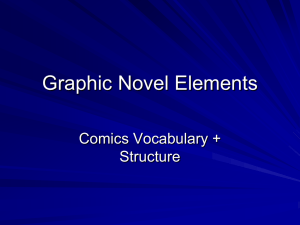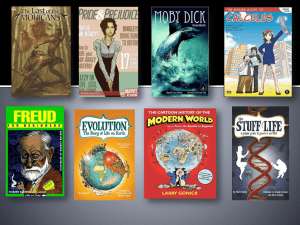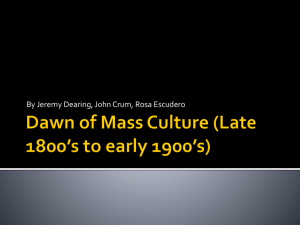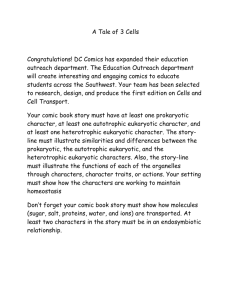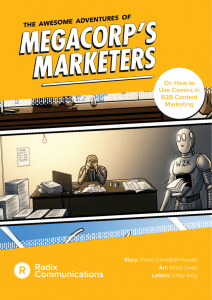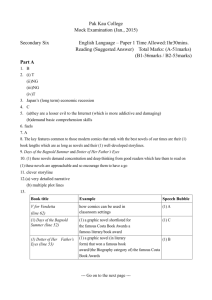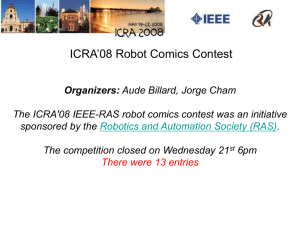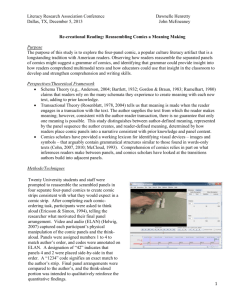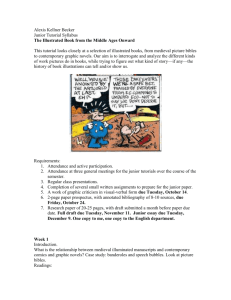Comic Books - Power of Comics
advertisement
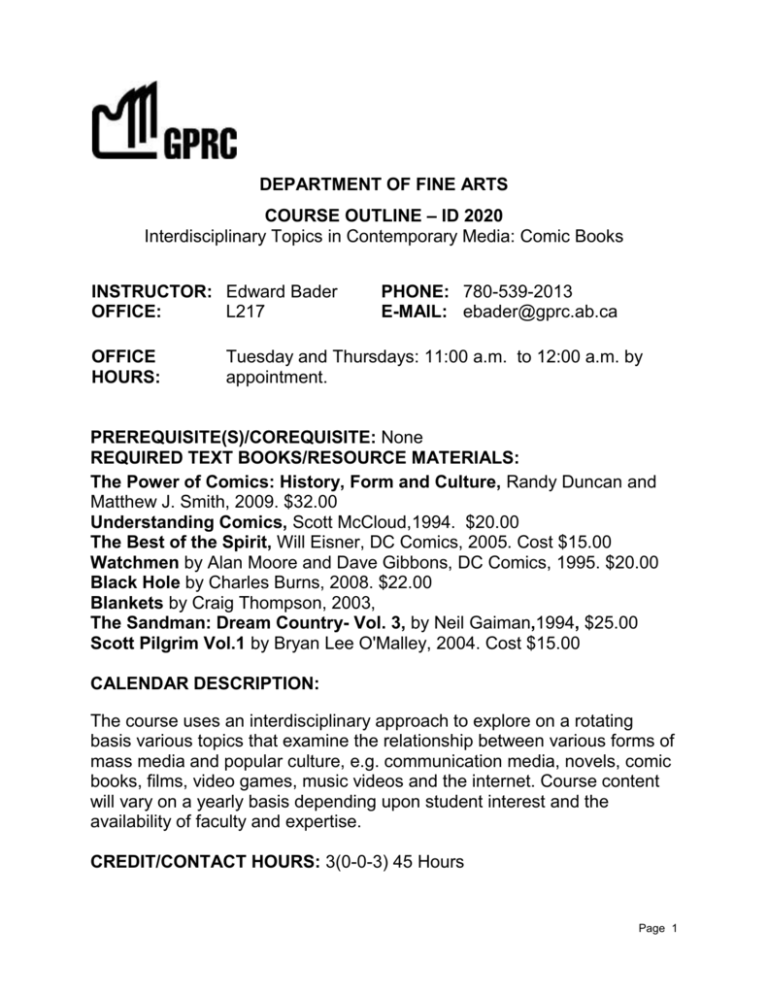
DEPARTMENT OF FINE ARTS COURSE OUTLINE – ID 2020 Interdisciplinary Topics in Contemporary Media: Comic Books INSTRUCTOR: Edward Bader OFFICE: L217 OFFICE HOURS: PHONE: 780-539-2013 E-MAIL: ebader@gprc.ab.ca Tuesday and Thursdays: 11:00 a.m. to 12:00 a.m. by appointment. PREREQUISITE(S)/COREQUISITE: None REQUIRED TEXT BOOKS/RESOURCE MATERIALS: The Power of Comics: History, Form and Culture, Randy Duncan and Matthew J. Smith, 2009. $32.00 Understanding Comics, Scott McCloud,1994. $20.00 The Best of the Spirit, Will Eisner, DC Comics, 2005. Cost $15.00 Watchmen by Alan Moore and Dave Gibbons, DC Comics, 1995. $20.00 Black Hole by Charles Burns, 2008. $22.00 Blankets by Craig Thompson, 2003, The Sandman: Dream Country- Vol. 3, by Neil Gaiman,1994, $25.00 Scott Pilgrim Vol.1 by Bryan Lee O'Malley, 2004. Cost $15.00 CALENDAR DESCRIPTION: The course uses an interdisciplinary approach to explore on a rotating basis various topics that examine the relationship between various forms of mass media and popular culture, e.g. communication media, novels, comic books, films, video games, music videos and the internet. Course content will vary on a yearly basis depending upon student interest and the availability of faculty and expertise. CREDIT/CONTACT HOURS: 3(0-0-3) 45 Hours Page 1 DELIVERY MODE(S): Lecture/Lab OBJECTIVES/LEARNING OUTCOMES: This course will offer a broad understanding of the medium of comic books and provide students with a coherent and comprehensive explanation of comic books, graphic novels, including coverage of their history, their communication techniques, research into their meanings and effects, the industry practices and the fan culture. TRANSFERABILITY: University of Calgary ** Grade of D or D+ may not be acceptable for transfer to other postsecondary institutions. Students are cautioned that it is their responsibility to contact the receiving institutions to ensure transferability. GRADING CRITERIA: ASSESSMENT AND GRADING: Mid-term Exam: 20% Grade TBA. Final: 20% Grade based on final exam TBA. Comic Book Responses: 10% Grade: Ongoing Class Presentations: 10% Grade: Ongoing Research Paper/Comic Book: 30% Grade Due: Tuesday, April 10th, 2012 Involvement: 10% grade based on participation and class attendance. You may choose for the major project of the term between the following: A. Research Paper: 1500 word type-written double spaced paper that is a historical or critical analysis of some aspect of comic books or comics culture and its role as a mass medium. Possible topics or discuss with your instructor a possible topic: 1. What role do comics play in contemporary youth culture verses comics’ historical role in the mid-20th century? 2. What has been the impact of “anime” on contemporary youth culture? 3. Since the 1990s the Comics Code Authority Seal of Approval has note been found on most comics. Do you think comics need external Page 2 regulation in terms of depictions of violence, race, gender and subject matter? 4. Superhero comics are no longer a mass medium phenomenon but instead the domain of “fan boys”. Do you agree or disagree? Outline: Thursday January 19th, 2012 Bibliography: Thursday, February 2nd, 2012 First Draft: Tuesday, February 28th, 2012 Final Draft: Tuesday, April 10th, 2012 Comic Book: If you have artistic or literary aspirations you may write and illustrate a 6 page autobiographical black and white comic book that is print ready. You are asked to work in your own style and not appropriate existing styles such as “anime”. Outline: Thursday January 19th, 2012 Script: Thursday, February 2nd, 2012 Page Thumbnails: Tuesday, February 28th, 2012 Final Comic Book: Tuesday, April 10th, 2012 Comic Book Response Papers Response Paper: Should be two to three pages (typed, double-spaced). You can refer to character traits and actions to support the points you are making, but there is no need to describe all the characters or summarize the plot of the book. Your overall aim is to illuminate how content and form combine to create the substance (meaning) of the work. As the semester progresses and you learn more about these concepts your book responses should become more sophisticated. Response 1: Visual Analysis: Spirit story by Will Eisner (Written or drawn). Based upon your reading of Scott McLeod’s Understanding Comics: Chapters 1 to 5 you are asked to do analysis of how meaning is developed in one of the stories included in this collection. You might consider these questions: 1.What is the meaning/subtext that you derive from this work? Page 3 2. How do layout (arrangement of panels on the page), composition (elements within the panel), encapsulation (breaking down the narrative into panels) and closure (meaning created by the combination of panels) contribute to the meaning? The language of cinematography is suited to the analysis of panel composition. 3.Are there other reasons why the work is significant? 4. Be cognizant of the material properties of the graphic novel. It’s overall design in terms of “it’s size, shape, paper and binding” may reinforce or work against its content and should be considered. Visual Analysis: If you have artistic aspirations or talent you may do a 5 page visual analysis by copying and studying how the artist has laid hot the graphic novel. Provide notes regarding composition, angles, points of view, transitions between pages and scenes. Response 2: Captain America: Compare the various versions of Captain America from 1940s, 60s and 21st century. How has Captain America been rebooted or adapted over the years to represent the ideals of each time period. (Graphic Novels will be distributed in class and on reserve in the library). Response 3: Compare/Contrast Black Hole and Blankets: Critically examine how these two graphic novels depict adolescence and themes of transformation. Response 4: Sandman: Dream Country: Discuss how the story A Midsummer Night's Dream references the works of William Shakespeare. Response 5: Compare/Contrast the Comic vs. Movie: Watchmen or Scott Pilgrim Saves the World Group Presentations: #1: Scott McCloud’s Understanding Comics: The Invisible Art You will read Scott Cloud’s Understanding Comics and be responsible for creating a 10-minute presentation that summarizes the material in the chapter your group has been assigned. You are asked to create a lecture, plus support materials such as handouts summarizing important concepts to be distributed to your classmates. Page 4 Group 1: Chapter 2 The Vocabulary of Comics Group 2: Chapter 3 Blood in the Gutter Group 3: Chapter 4 Time Frames Group 4: Chapter 5 & 6 Living in Line, Show and Tell Group 5: Chapter 7 The Six Steps #2: International Comics Presentations: You will research and present information on comics in other countries. Examine their origins, key features and influence if any have they had on the greater world of comics. Your presentation should be 10 minutes in length. You should use a minimum of six sources in addition to your textbook. You may not use the Internet for all of these sources. Your topics are visual in nature, so make sure you have plenty of visual support in your presentation. Make a handout for the class (I can copy it an distribute it next class meeting) You should begin your research early, as much of the information is challenging to locate. You will need to consult a minimum of six (6) sources and of these, only a third may come from the internet (e.g., two of six); however, you can consult primary works of the figures among your sources. I will ask you two to submit a working bibliography by the end of the second week of classes to be sure that you are working diligently on this research. Group 1: Canada Group 2: Great Britain Group 3: South East Asia/Indian Comics Group 4: Japan Group 5: France Group 6: Spanish Comics in Old & New World Individual Presentations: You will research and present information on an important historical figure in the history of comics and discuss their lives, influences upon their work, their impact and importance to the development of the comics medium or discuss comics in other countries. Your presentation should be 10 minutes in length. You should use a minimum of six sources in addition to your textbook. You may not use the Internet for all of these sources. Your topics are visual in nature, so make sure you have plenty of visual support in your presentation. Make a handout for the class (I can copy it an distribute it next class meeting) You should begin your research early, as much of the information is challenging Page 5 to locate. You will need to consult a minimum of six (6) sources in researching your figure. Of these, only a third may come from the internet (e.g., two of six); however, you can consult primary works of the figures among your sources. I will ask you two to submit a working bibliography by the end of the second week of classes to be sure that you are working diligently on this research. Topics: Auteurs: Will Eisner Jack Kirby Harvey Kurtzman Robert Crumb Jamie Hernadez Chris Ware Osamu Tezuka Herge Mobieus Trina Robbins Art Speigelman Frank Miller Neal Adams Seth Julie Doucet Yoshihiro Tatsumi Joe Kubert Neil Gaiman Alan Moore EXAMINATIONS: Mid-term: February 16, 2012 Final: TBA LATE ASSIGNMENTS/PAPERS WILL LOSE 10 % FOR EACH DAY THEY ARE LATE! A reminder that when applying for jobs, grants, or other educational institutions if your materials do not arrive by the due date specified they will not be considered. So manage your time well. Also if you complete your Page 6 paper ahead of time it allows the instructor an opportunity to provide feedback and improve the quality of your paper. STUDENT RESPONSIBILITIES: Students are expected to take notes from lectures during class as material from lectures will be examined. Note: Lectures will not be posted on Moodle. You are expected to arrive on time and remain for duration of class and related activities. See GPRC Admissions Guide 2011-12 p. 49. ELECTRONIC DEVICES IN THE CLASSROOM: No IPOD or MP3 players allowed with put permission!!!! You must have your own headphones to listen to music during work periods. All cell phones must be turned off. Failure to do so will result in you being asked to leave the class. STATEMENT ON PLAGIARISM AND CHEATING: Please refer to page 50 of GPRC Admissions Guide 2011-12 regarding plagiarism, cheating and the resultant penalties. These are serious issues and will be dealt with severely. COURSE SCHEDULE/TENTATIVE TIMELINE: Students can expect to put in a minimum of 4 hours per week on out-ofclass work. Assignments will be expected on the date required. R Jan 5 Introduction to the course Lecture 1: Defining the Comics Medium Readings: Power of Comics: Chapter 1 Understanding Comics: Chapter 1 T Jan 10 Research Paper/Comic Book Lecture 0: Writing about Comic Books Lecture 2: What are Comics? R Jan 12 Lecture 3: Comics as Communication Readings: Understanding Comics: Chapter 2 -6 Bibliography: Auteur Presentation Page 7 T Jan 17 Group Presentation: #1: Understanding Comics R Jan 19 Lecture 4: Comics as Communication Readings: Power of Comics: Chapter 2 T Jan 24 Lecture 5: Origins of Comics Book Response 1 - Visual Analysis: Spirit R Jan 26 Lecture 6: Comics and Commerce Research Paper Outline/Comic Book Outline T Jan 31 Lecture 7: The Adventure Strips R Feb 2 Lecture 8: Birth of the Comic Book & The Superhero Readings: Power of Comics: Chapter 10: Comic Book Genres: The Superhero Book Response 2 - Compare the various versions of Captain America from 1940s, 60s and 21st century. T Feb 7 Lecture 9: The Superhero Narrative Research Paper Bibliography R Feb 9 No Class: FAD Student for a Day T Feb 14 Lecture 10: Mid-term Review Comic Book: Script R Feb 16 Mid-term (Material covered will be lectures, readings and presentations). Readings: Power of Comics: Chapter 5: The Comic Book Creators MID-TERM BREAK T Feb 21 Individual Presentations: Auteurs R Feb 23 Lecture 11: Comics of Post WW2 Era T Feb 28 Lecture 12: New Genres Page 8 Readings: Power of Comics: Chapter 3: Maturation of a Medium Research Paper: First Draft/Comic Book:Thumbnails R March 1 Lecture 13: Censorship and The Comics Code Authority Readings: Power of Comics: Chapter 3: Maturation of a Medium T March 6 Lecture 14: The Silver Age: Rebirth Book Response 3 – Compare/Contrast Black Hole and Blankets Readings: Power of Comics: Chapter 4: The Comic Book Industry R March 8 Lecture 15: Mainstream Comics in the 70s. Readings: Power of Comics: Chapter 13: Comics Cultures around the World T March 13 Lecture 16: Underground Comics R March 15 Lecture 17: The Direct Market Emerges & The Dark Age T March 20 Lecture 18: Alternative Comics and the Graphic Novel Readings: Power of Comics: Chapter 8: The Comic Book Readers Book Response 4 – Sandman: Dream Country R March 22 Lecture 19: Fandom and subcultures T March 27 Lecture 20: Comics and Movies T March 29 Watchmen Screening R April 3 Scott Pilgrim Screening Readings: Power of Comics: Chapter 13: Comics Culture Around the World T April 5 Lecture 21: Comics as Cultural Artifacts Book Response 5 – Compare/Contrast the Comic vs. Movie Page 9 R April 10 Research Paper: Final Draft/Comic Book: Final Version due Class presentation on research/ critique on comic book T April 12 Lecture 22: Review for final TBA Final Exam: April 23rd, 11:30 a.m. GRANDE PRAIRIE REGIONAL COLLEGE GRADING CONVERSION CHART Alpha Grade 4-point Equivalent Percentage Guidelines A+ 4.0 90 – 100 A 4.0 85 – 89 A– 3.7 80 – 84 B+ 3.3 77 – 79 B 3.0 73 – 76 B– 2.7 70 – 72 C+ 2.3 67 – 69 C 2.0 63 – 66 C– 1.7 60 – 62 D+ 1.3 55 – 59 D 1.0 50 – 54 F 0.0 0 – 49 FAIL WF 0.0 0 FAIL, withdrawal after the deadline Designation EXCELLENT FIRST CLASS STANDING GOOD SATISFACTORY MINIMAL PASS Page 10
